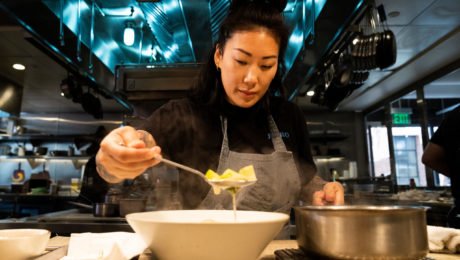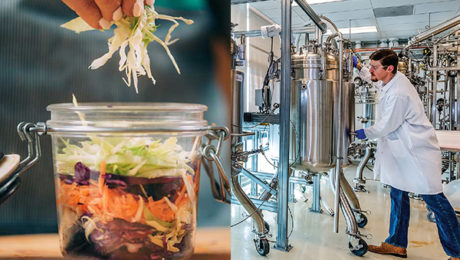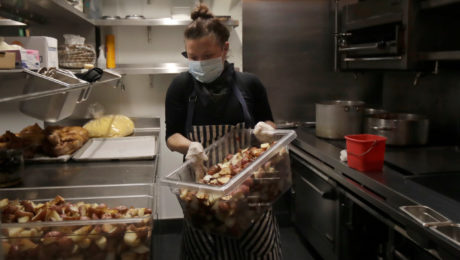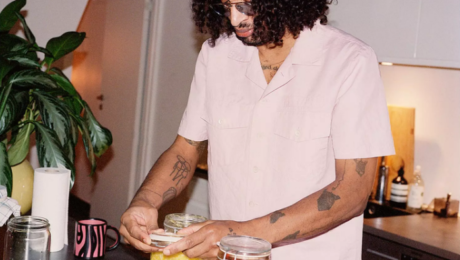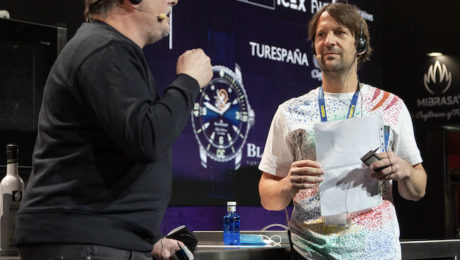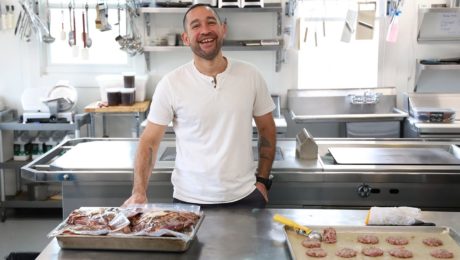Jason White Leaves Noma Amidst Its “Biggest Transformation”
Jason White has resigned as director of fermentation for Noma. He will be CEO and co-founder of a yet-to-be-announced biotechnology company in the United States. White tells The Fermentation Association that he will share details of his new project in the coming weeks.
Regarded as one of the best restaurants in the world, Noma earned their third Michelin star last year.
This summer, Noma owner Rene Redzepi announced that 2023 – the 20th anniversary of Noma – will be “our final year with Noma as we know it.”
“We have a plan, and I can’t wait to share more with you later this year, but for now, know that big changes are happening,” Redzepi wrote on Instagram, adding it’s “our biggest transformation so far…We’ve been laying some new foundational stones so we can continue to grow as an organization for the next 20 years.”
The staff had planned to take off this fall to travel to an undisclosed (but rumored to be in Mérida, Mexico) international location to learn some new cooking techniques and open a pop-up restaurant. But both the travel and pop-up have been postponed until spring 2023 due to ongoing travel restrictions related to the Covid-19 pandemic.
Last year Noma launched Noma Projects, a direct-to-consumer product line aimed at generating more revenue for the restaurant. In June, Bloomberg reported the restaurant was unprofitable in 2021 – the first time in four years – losing 1.69 million krone (~$225,000) after recording a small profit the prior year. Noma also received 10.9 million krone (~$1.45 million) from the Danish government in Covid-19 relief.
Noma’s previous head of the fermentation lab, David Zilber, also left the restaurant for a job in the biotech industry. He is a food scientist at Chr. Hansen.
White, who spoke at the 2nd international Food Innovation Conference this summer (produced by the Gottlieb Duttweiler Institute (GDI)), said fermentation is motivating scientists to listen to gastronomers.
“There’s going to be a huge exchange in this two-way road that we’re living in. Innovation in flavor coming from gastronomy and innovation coming from a high-level biotechnology, they are going to be harmonious,” White said. “We’re going to be able to create this infrastructure and community of people who have the same goal, and the same goal is going to be the wellness of our planet.”
- Published in Business
“Koreanique” Food
As more Korean adoptees come of age to run restaurants, a new dining style is emerging: “Koreanique” (or Korean-style, Korean-inspired or “kinda Korean”).
“For these chefs, cooking is the ultimate reclamation of their Koreanness — and an act that pushes the cuisine to exciting places,” reads an article in The New York Times.
They produce dishes that “reflect their American upbringings and Korean heritage” of the adoptee chefs. Examples are: Jewish matzo ball soup with Korean mirepoix, Spam musubi burritos, kimchi-enriched carbonara, chicken marinated in kimchi brine, battered fish-sauce-laden zucchini with a sweet soy dipping sauce, jajangmyeon sauce with Bolognese and gochujang barbecue sauce.
Still, they note, feelings of imposter syndrome and cultural appropriation can take over. Adoptee chefs tell The Times they worry they’re not making Korean food authentically and they struggle with their complicated relationships with Korean food when they grew up eating a different culture’s food.
Read more (The New York Times)
- Published in Food & Flavor
Will Fermentation Connect Gastronomy and Biotech?
Fermentation is motivating scientists to listen to gastronomers, a rare occurrence in the field of science.
“There’s going to be a huge exchange in this two-way road that we’re living in. Innovation in flavor coming from gastronomy and innovation coming from a high-level biotechnology, they are going to be harmonious,” says Jason White, director of the fermentation lab at Noma in Copenhagen. “We’re going to be able to create this infrastructure and community of people who have the same goal, and the same goal is going to be the wellness of our planet.”
White spoke at the 2nd international Food Innovation Conference. This annual gathering of industry experts is produced by the Gottlieb Duttweiler Institute (GDI), Switzerland’s oldest independent think tank, which researches the future of food, retail and health.
The conference focused on the future of fermented alternative proteins. Or, as GDI puts it: “how innovation can solve the carnivore conundrum.” Speakers included the founders of numerous precision fermentation companies, such as SuperBrewed Food, Bosque Foods, Melt&Marble and WNWN Food Labs.
“We do the same thing, we just have different outputs”
Fermentation for alternative proteins is a divisive topic among traditional fermenters. Many say it’s lab-created fake food. Advocates, though, argue precision fermentation using DNA from mammals (as with Impossible Foods’ heme protein burger) and biomass fermentation of fast-growing, naturally-occurring organisms(e.g., Nature’s Fynd fungi protein) are reducing the risk of a global food crisis. Meat consumption is increasing, but animal meat is environmentally inefficient to raise. The significant amounts of agricultural land, fertilizer, pesticide and hormones needed to raise animals for meat protein release harmful carbon emissions.
The chefs on GDI’s “Fermentation: A World Within Gastronomy” panel spoke favorably of using fermentation for alt foods. White was joined by Ezio Bertorelli, co-founder of fermentation shop Meta Copenhagen, and Sirkka Hammer, founder of food manufacturer Wiener Miso in Austria.
“I think that it’s important for us not to steer too far away from the origins of fermentation,” White notes. But, “whether you have this bioreactor filled with whatever working inside of a laboratory with a team of scientists, we are still creating something that comes from microorganisms and from organisms. And so we do the same thing, we just have different outputs, different audiences.”
Precision fermentation technology is rooted in traditional fermentation, he notes. You need to understand the abilities of microbes and composition of ingredients for a successful precision fermentation.
“Inside of these laboratories and restaurants, there’s so many things that are being discovered that stop at the guest experience,” White says of fermentation. Today, as fermentation continues a revitalization as a kitchen craft, it’s utilized by more people rather than just chefs and scientists.
DIscovering Fermentation
Hammer highlighted the boom in home fermentation, with people creating the bold flavors of fermented foods and beverages on their own countertops.
“There’s a certain magic in fermentation. That’s why you’re gripped with it,” she says. “People are bringing a little bit of that magic, uncontrollable magic maybe [into their homes].”
At Wiener Miso, Hammer launched the company’s umami-driven ferments after living in Asia for more than a decade. The spices, pastes and sauces she makes are based on traditional Japanese ferments.
“Fermenting gives you in gastronomy next level or an add-on of flavors and textures,” she says. “Fermentation really changes the texture in a different way than if you cook it or freeze it. It gives it new dimensions.”
Flavor is what introduced Bertorelli to fermentation, too. His background is in professional cooking – he is the former executive chef of La Petite Table in Paris – but he was always experimenting with miso and sauerkraut in his home kitchen.
Even today, his fermentation experiments “go terribly wrong most of the time,” says Bertorelli. Only about 5% are successes, “that’s what makes it exciting.”
“Fermentation really changed my life because it showed me most of the dishes I was passionate about, the origin of the flavor, was the fermented part,” he says. “Flavor is universal… If you have that mind-blowing moment, it can reconnect you with things that are inside all of us, like our ancestors have been eating these foods since thousands of years ago and it’s sort of like going back in time while still being here.”
- Published in Food & Flavor
Scamming Restaurants
A new scam is threatening restaurants’ reputations: leaving one-star reviews.
In recent days, small, large and even Michelin-starred restaurants across the U.S. have received a barrage of poor reviews on Google. These have no descriptions nor photos, simply the infamous one-star rankings. And, as restaurants try to recover from the coronavirus pandemic, owners report that, days later, they receive an email from someone claiming they posted the review and, if the restaurant wants it removed, they must pay up. If they don’t, the bad reviews will increase.
“You’re just kind of defenseless,” said Julianna Yang, the general manager of Sons & Daughters in San Francisco, who has taken on much of her restaurant’s response to the messages. “It seems like we’re just sitting ducks, and it’s out of luck that these reviews might stop.”
Law enforcement is encouraging restaurant owners to contact Google, and to report these cybercrimes to their local police department, the F.B.I. and the Federal Trade Commission. Removing the reviews – and tracking down the anonymous posters – is an almost hopeless task. Google has an automated system to monitor reviews for abuses. But it’s challenging for restaurants to reach someone at Google, with many reviews never being removed.
“We don’t have a lot of money to fund this kind of crazy thing from happening to us,” said an owner of Sochi Saigonese Kitchen in Chicago. Her one-star reviews were removed after customers came to her defense on social media.
“This is another nightmare for us to handle,” said William Talbot, manager at EL Ideas Restaurant in Chicago. “I’m losing my mind. I don’t know how to get us out of this.”
Read more (The New York Times)
- Published in Business
Can the Grocery Industry Adapt?
Three years ago, industry experts predicted a mass retail apocalypse. Consumers were expected to order everything online, abandoning physical stores for websites. The stress of Covid-19 accelerated the trend, shuttering many retailers for good. But one retail category unexpectedly thrived in the pandemic: grocery stores.
“In this environment that should have killed the grocery store in many cases, not only did it not kill it, it strengthened it,” says Ethan Chernofsky, vice president of marketing at Placer.ai, a tech company that tracks and analyzes foot traffic for retailers. “People love grocery shopping and they very often prefer the visit to the store.”
“There’s a love affair with grocery stores,” says Christine LaFave Grace, executive editor of Winsight Grocery Business, a trade publication for the grocery industry..
In the midst of another wave of Covid cases, the war in Ukraine and rising costs due to inflation, “there’s a really continued, sustainable opportunity for the grocery space,” Chernofsky says. Though consumers’ dollar spend at grocery stores has far exceeded industry estimates, the industry needs to adapt to a changing customer.
Chernofsky and Grace shared their views on the marketplace in Winsight’s webinar “2022 Grocery Deep Dive: What’s Changed and Who’s Thriving.”
Regional Shifts
During the pandemic, many consumers – especially young families – left city centers for the suburbs.The suburban grocery shopping experience is new and different for former city dwellers – stores are bigger, selection is greater and the shopper’s pantry space at home is typically much larger.
“A lot of these changes really demand that grocers on a regional and a location-based level to say: ‘What’s changed in our specific area? Where does it provide us with opportunity? Where does it provide us with risks?’” he adds. These are not huge overhauls like moving stores, but minor adapting moves “to better align myself with where the opportunities are.”
For example, coffee shops are one of the strongest performing sectors within the food industry. Grocery stores with on-site coffee bars and an in-house bakery create a similar experience for their shoppers. Selecting merchandise tailored for a local audience also creates a differentiated shopping experience.
“Grocery stores are hitting a whole other level of potential that wasn’t possible a few years ago,” Chernofsky says. “It’s a fundamental shift in what we expect from these areas.”
Recession-Proof
Grocery stores have shown their staying power during economic downturns, since they sell essential products. As America braces for another recession – 68% of CEOs in a recent survey feel one is imminent – buying patterns in groceries are likely to change but not decrease.
“Difficult economic environments [do] not mean everything comes to standstill,” Chernofsky says. People may not have as much money to spend at the grocery store, but they’re still spending.
For example, if restaurant spending drops – as it typically does in a recession – grocery stores can offer consumers the eating-out experience by selling DIY meal kits and grab-and-go meals.
“Everything we’re seeing to this point is showing us demand has been incredibly resilient,” Chernofsky says. “The retailer has to continue to evolve and push to innovate.”
- Published in Business
Chef’s Secret: Fermented Bean Curd
Chef Andrew Wong created the first Michelin two-star Chinese restaurant outside Asia. His London-based A Wong is an homage to China’s 3,000-year culinary history and a contemporary spin on the country’s regional cuisine.
Fermented wild sea bass and fermented coconut are part of the “Taste of China” dinner menu. A popular dish called “Why the Buddha Didn’t Jump Over the Wall” is barbecued sweet potato covered in a fermented, salted black-bean relish. It’s no surprise Wong’s favorite ingredient is fermented bean curd. He says the tofu, soaked in salt and chili, is as close to cheese as you can get in China. It’s eaten with congee and used as a condiment.
“It’s very salty; umami in its purest form,” Wong says. “I use it a lot in my cooking, especially in vegetarian dishes where we can’t use oyster sauce. We cook it out with some stock, ginger, garlic, and make a sauce. The combination of vegetables, garlic, chili and fermented bean curd creates a really deep meaty flavor.”
He advises chefs to use it like a stock cube, because it’s soft and will coat the mouth in umami flavor.
Read more (Guardian)
- Published in Food & Flavor
Zilber: Fermentation’s Endless Potential
David Zilber says the potential for fermented food is endless. “There isn’t any sort of food that doesn’t benefit from some aspect of fermentation,” he said. “There’s really no limitation to its application.”
Zilber, the former head of the Noma fermentation lab, co-authored “The Noma Guide to Fermentation” with Noma founder Rene Redzepi. In the fall of 2020, Zilber surprised the food world when he left his job at Noma to join Chr. Hansen, a global supplier of bioscience ingredients.
He shared his insight on fermentation on The Food Institute Podcast. An Oxford study found over 30% of the world’s food has been touched by microbes. Zilber, a microbe champion, says one of the best parts of fermenting with plant-based ingredients is the microbes don’t need to change.
“We do need to find ways to adapt them to new sources, but there will always be a place within the pie chart of what humans are eating on earth for fermentation,” he says.
Part of Zilber’s work at Chr. Hansen is in the plant-based protein alternative segment, fermenting plant ingredients to “bring this other set of characteristics” to a new food item. He advises fermenters using plant-based ingredients to make their ingredient list concise and pronounceable to consumers.
“I am a huge proponent for formulating recipes from whole ingredients,” Zilber says. “Keeping the ingredient list short and concise and using natural processes to achieve flavor or textual properties … because it is the healthiest way to eat.”
Across the spectrum of fermentation, he feels fermented beverages is the category where he sees the greatest opportunity.
Read more (The Food Institute)
- Published in Food & Flavor
Redzepi on the Changing Fine Dining Industry
Expect more changes to fine dining as the restaurant industry grapples with Covid-19 changes, casual eateries adapt more fine dining techniques and the war in Ukraine continues to affect the world economy.
“Everyday restaurants have become so amazing. It’s not like it used to be, you used to go to the best restaurant to get the most tender piece of meat and the perfect ice cream,” says Rene Redzepi. He is the founder of Noma, the Michelin three-star restaurant in Copenhagen lauded as one of the top in the world. “You can find typical luxury ingredients like caviar and wagyu in airports. The quality of cooking now is so high.”
Redzepi spoke at Madrid Fusión, one of the largest and oldest international gastronomy conventions. Andoni Luis Aduriz, chef and owner of the renowned Spanish restaurant Mugaritz, spoke with Redzepi.
Redzepi says there’s been a “flavor spread” or “quality spread” of gastronomy techniques. He points to espumas, the Spanish term for culinary foaming. – now used on every continent, in every level of restaurant. A gourmet dish may come from the neighborhood brasserie, a tapas bar or even a food truck. It’s “dramatically changed” the restaurant industry, he notes.
“That’s because people don’t understand the influence and the philosophies that [are] now completely naturalized in every corner of gastronomy,” he says. Techniques once used only in premier establishments have become part of cooking DNA. “I hope fermentation will be that because I genuinely believe in the power of that.”
When Noma opened in November 2003, Redzepi promised Nordic cuisine made with local produce. But it was winter and freezing, making sourcing food a challenge, “so I stepped into the wilderness to find flavors.”
He also realized Noma needed to conserve summer produce for the long winter.
“We started to use pickling, fermentation, drying, smoking. Twenty years later, we have this bank of knowledge,” he said. “Before, we used to try 20,000 different fermentation techniques, now we are trying one at a time, with the whole team, like we are doing with lacto-fermentation.”
Fermentation drives an enormous amount of innovation at Noma. Redzepi told the Madrid Fusion audience that the restaurant industry is one of the most difficult to work in, so innovation and experience are what drive profitability.
“That’s what makes it special, putting together a team, while constantly looking for the ‘next big thing,’” he says. “That’s where the challenge is; pushing yourself outside of your comfort zone, until you have no clue what you’re doing, but as a group, you draw on your experiences, you trust each other, and you dare to move onwards.”
Redzepi praised the current state of Spain’s cuisine, saying “the Spanish influence is a natural part of any fine dining kitchen in the Western world.”When he was starting out in the 90s, French food was the only focus for chefs. “You were going to cook French food in Denmark, that’s what I always thought to myself.” But when he took a job cooking in Spain for a season, “it was like everything that you had been taught before, all your rules that you knew, were sort of thrown away and you could build and dream in a different way. “[Spanish cuisine] has given me the very seed of everything that’s become Noma.”
- Published in Food & Flavor
Zero Waste with Fermentation Techniques
Paste Magazine highlights the fermentation philosophy of Chef David Porras, who operates the Oak Hill Café and Farm. The hyper-local site, a 2020 James Beard semi-finalist for Best New Restaurant, operates in Greenville, South Carolina, on a 2.4-acre farm.
Porras’ kitchen, according to the magazine, “looks like an alchemist’s workroom, jars and tubs of experimental pickling, emulsions and infusions dotting the counter.”
“I was always interested in learning about fermentation. Fermentation is a flavor — you can use it for cooking just like lime or lemon juice,” he said.
The restaurant’s menu reflects a true farm-to-table approach. They use permaculture (sustainable agriculture planning to mimic nature) to keep the farm at peak fertility to grow healthy produce. By fermenting instead of trashing unused food, they’ve reduced 50% of their food waste.
“We try to be zero waste by applying fermentation techniques as well as drying, infusion, teas, powders and compost tea,” he said.
Read more (Paste Magazine)
- Published in Food & Flavor
“The World Has Woken Up to Fermentation” — David Zilber
Big food companies are “eager to tap into the magic of fermentation,” says chef David Zilber. They’re hungry to hire culinary experts who can use fermentation to enhance existing products or mold the flavor profiles of new ones.
“These big companies are all waking up to the trend of fermentation and it is on us, on anyone who understands this craft intimately, to be the ones to engage them and guide them towards better solutions,” Zilber said at KojiCon. Fermenters could go the traditional route and open a local shop to feed a small number of people. But “there’s also a lot to be said for working within an existing system and fermenting the change you want to eat in the world. The biggest food producers in the world are responsible for nourishing most of mankind.”
The former head of the Noma fermentation lab, Zilber co-authored The Noma Guide to Fermentation with Noma’s founder Rene Redzepi. In the fall of 2020, Zilber surprised the food world when he left his job at Noma to join Chr. Hansen, a global supplier of bioscience ingredients.
Zilber said he understands the push-and-pull between working in traditional fermentation vs. large-scale food production. Though he cherished his time at Noma, he realized fine dining is “a minuscule fraction of the amount of food people eat” and, if he wanted to influence any big change in the food industry, he needed to move away from restaurants. He compared it to being “the punk rocker that rails against the system” when instead “subverting it from the inside is an amazing way to effect change extremely quickly.”
“When you learn to speak bacteria or when you learn to speak fungus, the hardcore food scientists don’t have this intuition,” he continues. “They grow these things in petri dishes and with colony pickers in €20,000 machines. It’s not the same thing, and we are a little bit at a watershed moment where there is enough community knowledge…that we can start to broach these players and try and change it.”
Streaming into KojiCon from his state-of-the-art kitchen at Chr. Hansen’s Copenhagen headquarters, Zilber shared his latest project: a tomato sauce for a client, improved through fermentation. In his kitchen, he works with chefs and food companies to use fermentation to develop healthier and more sustainable products. Holding up a sample of tomato sauce to the KojiCon attendees, Zilber shared how he was able to amplify the flavor profile of the canned tomato sauce using fermentation. He eliminated added white sugar and created a flavor with hints of parmesan cheese.
“We haven’t added anything but a culture onto it,” he said. “At the end of the day, should this tomato sauce go into production, millions of people overnight will be eating a tastier, probiotic (filled), more nutritious food on their pasta. And I never had to teach them how to lacto-ferment a single thing.”
Chr. Hansen is building one of the largest collections of cultures in the world, currently totalling 40,000 specimens. Zilber describes it as a seed bank, “the Noah’s Ark of Life for microbial diversity.” Chr. Hansen works with companies to select the optimal culture for their food item.
Smaller-scale producers, too, purchase cultures, often to mitigate risk. A fermentation mistake in a one-ton batch of kimchi could destroy thousands of dollars worth of product. Using a guaranteed culture strain will allow them to produce kimchi of consistent quality. But Zilber acknowledges there is no wild fermentation, no son-mat – a common phrase in Korean cooking that literally translates to “the taste of one’s hands.”
“There are aspects of the world of fermentation that are decidedly unwild, there are aspects of the world of fermentation that are nothing but wild,” he says.
Zilber believes we’re in the era of the democratization of fermentation, where books and educational courses are teaching the public about fermentation. He mentioned the new Sex and the City reboot featured a scene where a character was angry that sourdough challah was “too hipster.”
“It’s funny that it’s permeated public consciousness that much where we can now make jokes about it in multi-million-dollar, prime-time television shows. It means that the idea of fermentation in that respect has reached fixation. The world has woken up to this.”
- Published in Business, Food & Flavor, Science


